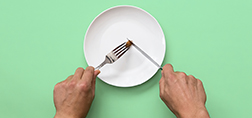
You’ve landed on the nice list for eating right all year. Now comes the real test: the holidays.
The season’s table is traditionally heavy with rich and fatty dishes, salty hors d’oeuvres and sweet treats. And that can make it a challenge if you’re trying to eat healthy.
“The holidays can be tricky,” Jessica Corwin, registered dietitian at the Corewell Health Women’s Health and Wellness Center, said. “We all want to eat those traditional holiday dishes. And we can, but in moderation—and with a few changes.”
With so many tasty choices, overeating is common during the holidays. Smaller portion sizes, however, can allow for the occasional transgression.
“Make half of your plate vegetables,” Corwin said. “Meat should be only about a quarter of the plate. Keep your slice of ham, roast beef or turkey palm-size. That’s about 3 ounces.
“Grass-fed has a healthier balance of fats and may offer environmental benefits for our planet.”
Meat matters
A turkey takes center stage on many holiday tables. And that’s a good thing.
“Turkey can be one of the healthier meats,” Kristi Veltkamp, RDN, registered dietitian nutritionist at Corewell Health, said. “Especially if it is pasture-raised, meaning that the bird has eaten grass and bugs out in the pasture and not just grain.”
Preparation is key.
Veltkamp recommends roasting the bird rather than deep-frying, grilling or smoking it.
“People often think grilling or smoking the turkey is a healthy option, but these are techniques that actually produce carcinogens,” she said. “When fat drips into the fire, you get smoke. And smoke is full of cancer-causing carcinogens.”
Frying is the least-healthy option, she said.
Other popular holiday meats include beef and ham.
When preparing beef, seek leaner cuts, such as chuck, round or sirloin, Corwin said.
“Grass-fed can be leaner and have higher healthy omega-3 fats,” she said.
The leaner cuts can be tougher. Corwin recommends using more acidic marinades when preparing them, to help break down the tissue.
No matter what cut of meat you choose, aim for free range—it’s better for you.
“Keep in mind that what the animal eats, you eat,” Veltkamp said.
For the same reason, if you decide to have fish, consider buying wild rather than farm raised.
“Wild-caught fish have more omega-3 in them,” Veltkamp said. “And some easy options with high omega-3s are salmon and tuna.”
An added concern with eating fish: mercury content. The bigger and more mature the fish, the more mercury accumulated in its flesh.
“For that reason, if you choose tuna, limit albacore tuna to once a week,” Veltkamp said.
Both dietitians agree that ham, with its high sodium content, can be the least-healthy option to put on the holiday table.
“Especially if you have health issues such as a heart or kidney condition, something that restricts your sodium intake,” Corwin said. “Ham is extremely high in sodium and one serving can put you well over your daily allowed intake.”
If you do eat ham, drink plenty of water to flush the sodium out. Eating foods that contain potassium—such as fruit salad, veggies or even chocolate-dipped strawberries—can help eliminate excess sodium.
“Pork loin is a better option than ham,” Veltkamp said. “With healthy marinades, you can prepare a delicious meal without all that sodium in ham.”
Target sneaky calories and salt
Both dietitians recommend cooking holiday dishes in your own kitchen, rather than buying prepared dishes from a store or restaurant. Pre-prepared foods will always have higher content of fats and sodium, often with preservatives and other additives.
“Keep your foods as close to how nature made them as possible and you’ll do OK,” Veltkamp said.
Fatty calories can often sneak into an appetizer spread. Charcuterie trays, for example, may be loaded with unhealthy calories.
“Rather than creamy or salty appetizers, prepare a veggie tray for munching,” Corwin said.
And don’t forget to eat a good breakfast before that big holiday meal.
“Some people skip breakfast to make room, but that’s the opposite of what you want to do—and (it) can lead to overeating,” Corwin said.
Call in a sub
Many calories can show up in side dishes.
The good news: Some of your favorite recipes can be made healthier without losing flavor.
“Some of these sides we love can have a lot of cheese or cream sauces added,” Veltkamp said. “Cut back on those and substitute something like a sauce or dressing made with honey mustard or maple syrup glaze. Use herbs and spices to add more flavor, without adding calories.”
Some healthy changes are easy substitutes, additions or subtractions.
Use olive oil instead of butter. Use yogurt instead of sour cream. Substitute a crisp topping of chopped, toasted nuts in place of sugars or marshmallows on your favorite sweet potato casserole.
Use caramelized onions rather than pre-made fried onions on your green bean casserole. Make a roux instead of opening a can of creamy soup.
Whatever approach you choose, don’t lose sight of the real value of holiday meals with loved ones.
“Food isn’t just food,” Corwin said. “Food carries with it so many family memories. The holiday table is how we gather with family and friends, so be realistic in your expectations.”
 /a>
/a>
 /a>
/a>
 /a>
/a>